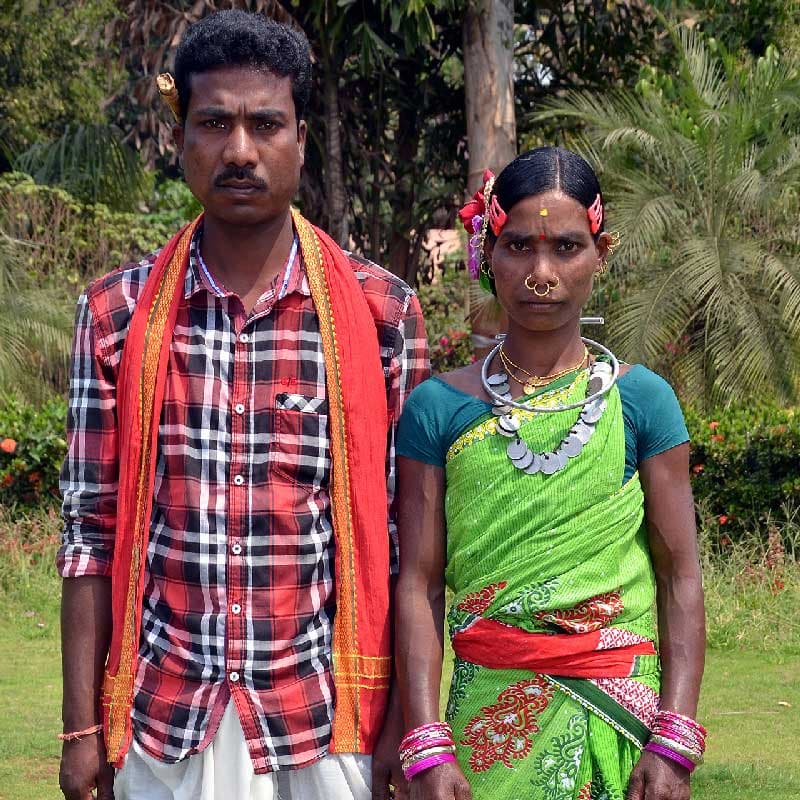TRIBES OF ODISHA
TRIBES OF ODISHA
Paroja
Parja, Bodo Paroja, Barong Jhodia Paroja, Chhelia Paroja, Jhodia Paroja, Konda Paroja, Paraja, Ponga Paroja, Sodia Paroja, Sano Paroja, Solia Paroja
Region: Paroja are concentrated in Koraput, Nabrangpur, Malkangiri, Rayagada and Kalahandi, but are also present in small numbers in Sundergarh, Keonjhar, Puri and Cuttack.
Population*: 3,74,628
Language: Parji and Desia
Map: Click Here
Origin: The term Paroja is a local Oriya term derived from the Sanskrit word Praja meaning common people, or the subjects of kings and zamindars. It may also mean tenant.
Occupation: The main sections of the tribe are the Bada, Penga, Baeng Jodia and Selia Paroja. The Selia are known to have been goat-herders in the past. The tribe mainly practices wet and dry cultivation, and has almost abandoned shifting agriculture. They also tend to kitchen gardens of vegetables with great care. During the lean period, hunting, fishing and gathering of forest produce like mahua and jungle grass is carried out and cows, goats, pigs and fowl are also reared. Like most other communities in the region, the animals are not milked but are used only for draught labour.
*Scheduled Tribes Population as per Census 2011 data. PVTGs Population as per Micro Project Survey Data, 2010
Paroja
Parja, Bodo Paroja, Barong Jhodia Paroja, Chhelia Paroja, Jhodia Paroja, Konda Paroja, Paraja, Ponga Paroja, Sodia Paroja, Sano Paroja, Solia Paroja
Region: Paroja are concentrated in Koraput, Nabrangpur, Malkangiri, Rayagada and Kalahandi, but are also present in small numbers in Sundergarh, Keonjhar, Puri and Cuttack.
Population*: 3,74,628
Language: Parji and Desia
Map: Click Here
Origin: The term Paroja is a local Oriya term derived from the Sanskrit word Praja meaning common people, or the subjects of kings and zamindars. It may also mean tenant.
Occupation: The main sections of the tribe are the Bada, Penga, Baeng Jodia and Selia Paroja. The Selia are known to have been goat-herders in the past. The tribe mainly practices wet and dry cultivation, and has almost abandoned shifting agriculture. They also tend to kitchen gardens of vegetables with great care. During the lean period, hunting, fishing and gathering of forest produce like mahua and jungle grass is carried out and cows, goats, pigs and fowl are also reared. Like most other communities in the region, the animals are not milked but are used only for draught labour.
*Scheduled Tribes Population as per Census 2011 data. PVTGs Population as per Micro Project Survey Data, 2010
Paroja
Parja, Bodo Paroja, Barong Jhodia Paroja, Chhelia Paroja, Jhodia Paroja, Konda Paroja, Paraja, Ponga Paroja, Sodia Paroja, Sano Paroja, Solia Paroja
Region: Paroja are concentrated in Koraput, Nabrangpur, Malkangiri, Rayagada and Kalahandi, but are also present in small numbers in Sundergarh, Keonjhar, Puri and Cuttack.
Population*: 3,74,628
Language: Parji and Desia
Map: Click Here
Origin: The term Paroja is a local Oriya term derived from the Sanskrit word Praja meaning common people, or the subjects of kings and zamindars. It may also mean tenant.
Occupation: The main sections of the tribe are the Bada, Penga, Baeng Jodia and Selia Paroja. The Selia are known to have been goat-herders in the past. The tribe mainly practices wet and dry cultivation, and has almost abandoned shifting agriculture. They also tend to kitchen gardens of vegetables with great care. During the lean period, hunting, fishing and gathering of forest produce like mahua and jungle grass is carried out and cows, goats, pigs and fowl are also reared. Like most other communities in the region, the animals are not milked but are used only for draught labour.
*Scheduled Tribes Population as per Census 2011 data. PVTGs Population as per Micro Project Survey Data, 2010
Paroja
Parja, Bodo Paroja, Barong Jhodia Paroja, Chhelia Paroja, Jhodia Paroja, Konda Paroja, Paraja, Ponga Paroja, Sodia Paroja, Sano Paroja, Solia Paroja
Region: Paroja are concentrated in Koraput, Nabrangpur, Malkangiri, Rayagada and Kalahandi, but are also present in small numbers in Sundergarh, Keonjhar, Puri and Cuttack.
Population*: 3,74,628
Language: Parji and Desia
Map: Click Here
Origin: The term Paroja is a local Oriya term derived from the Sanskrit word Praja meaning common people, or the subjects of kings and zamindars. It may also mean tenant.
Occupation: The main sections of the tribe are the Bada, Penga, Baeng Jodia and Selia Paroja. The Selia are known to have been goat-herders in the past. The tribe mainly practices wet and dry cultivation, and has almost abandoned shifting agriculture. They also tend to kitchen gardens of vegetables with great care. During the lean period, hunting, fishing and gathering of forest produce like mahua and jungle grass is carried out and cows, goats, pigs and fowl are also reared. Like most other communities in the region, the animals are not milked but are used only for draught labour.
*Scheduled Tribes Population as per Census 2011 data. PVTGs Population as per Micro Project Survey Data, 2010
PVTG Communities
62 Scheduled Tribes
PVTG Communities
62 Scheduled Tribes
PVTG Communities
62 Scheduled Tribes





